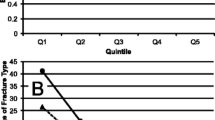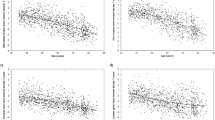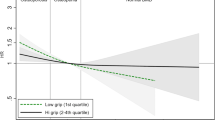Abstract
Summary
Weight loss is a risk factor for hip fractures, but few studies have evaluated the effect of weight loss on distal forearm fracture risk. In this longitudinal study including 7,871 postmenopausal women, weight loss of 5% or more was associated with an increased risk of distal forearm fractures.
Introduction
Weight loss is an established risk factor for hip fractures, but little is known about weight loss and distal forearm fractures risk.
Methods
The study included 7,871 women aged 65 years or more in the Nord-Trøndelag health study (HUNT) in 1994–1995 (HUNT II) who also had their height and weight measured in 1984–1986 (HUNT I). Forearm bone mineral density (BMD) by single energy x-ray absorptiometry was available for 5,688 women (HUNT II). Fractures sustained after HUNT II were registered during an average of 5.8 years.
Results
A total of 536 women sustained a distal forearm fracture. After adjustments for age and body mass index (BMI) at HUNT I, women who lost ≥5% of their weight between HUNT I and HUNT II had a relative risk of fractures of 1.33 (95% confidence interval: 1.09, 1.62) compared with the rest of the women. The higher risk of forearm fracture among women with weight loss was at least partially explained by their lower forearm BMD.
Conclusion
Weight loss of 5% or more was associated with a 33% increased risk of distal forearm fractures.


Similar content being viewed by others
References
Johnell O, Kanis JA (2006) An estimate of the worldwide prevalence and disability associated with osteoporotic fractures. Osteoporos Int 17:1726–1733
Barrett-Connor E, Sajjan SG, Siris ES et al (2008) Wrist fracture as a predictor of future fractures in younger versus older postmenopausal women: results from the National Osteoporosis Risk Assessment (NORA). Osteoporos Int 19:607–613
Hemenway D, Azrael DR, Rimm EB et al (1994) Risk factors for wrist fracture: effect of age, cigarettes, alcohol, body height, relative weight, and handedness on the risk for distal forearm fractures in men. Am J Epidemiol 140:361–367
Mallmin H, Ljunghall S, Persson I et al (1994) Risk factors for fractures of the distal forearm: a population-based case-control study. Osteoporos Int 4:298–304
Kelsey JL, Browner WS, Seeley DG et al (1992) Risk factors for fractures of the distal forearm and proximal humerus. The Study of Osteoporotic Fractures Research Group. Am J Epidemiol 135:477–489
Vogt MT, Cauley JA, Tomaino MM et al (2002) Distal radius fractures in older women: a 10-year follow-up study of descriptive characteristics and risk factors. The study of osteoporotic fractures. J Am Geriatr Soc 50:97–103
Silman AJ (2003) Risk factors for Colles’ fracture in men and women: results from the European Prospective Osteoporosis Study. Osteoporos Int 14:213–218
Ensrud KE, Lipschutz RC, Cauley JA et al (1997) Body size and hip fracture risk in older women: a prospective study. Study of Osteoporotic Fractures Research Group. Am J Med 103:274–280
Meyer HE, Tverdal A, Falch JA (1993) Risk factors for hip fracture in middle-aged Norwegian women and men. Am J Epidemiol 137:1203–1211
Meyer HE, Tverdal A, Selmer R (1998) Weight variability, weight change and the incidence of hip fracture: a prospective study of 39,000 middle-aged Norwegians. Osteoporos Int 8:373–378
Ensrud KE, Ewing SK, Stone KL et al (2003) Intentional and unintentional weight loss increase bone loss and hip fracture risk in older women. J Am Geriatr Soc 51:1740–1747
Langlois JA, Harris T, Looker AC et al (1996) Weight change between age 50 years and old age is associated with risk of hip fracture in white women aged 67 years and older. Arch Intern Med 156:989–994
Ensrud KE, Cauley J, Lipschutz R et al (1997) Weight change and fractures in older women. Study of Osteoporotic Fractures Research Group. Arch Intern Med 157:857–863
Gunnes M, Lehmann EH, Mellstrom D et al (1996) The relationship between anthropometric measurements and fractures in women. Bone 19:407–413
Margolis KL, Ensrud KE, Schreiner PJ et al (2000) Body size and risk for clinical fractures in older women. Study of Osteoporotic Fractures Research Group. Ann Intern Med 133:123–127
Marshall D, Johnell O, Wedel H (1996) Meta-analysis of how well measures of bone mineral density predict occurrence of osteoporotic fractures. BMJ 312:1254–1259
Forsmo S, Aaen J, Schei B et al (2006) What is the influence of weight change on forearm bone mineral density in peri- and postmenopausal women? The health study of Nord-Trøndelag, Norway. Am J Epidemiol 164:890–897
Hannan MT, Felson DT, Dawson-Hughes B et al (2000) Risk factors for longitudinal bone loss in elderly men and women: the Framingham Osteoporosis Study. J Bone Miner Res 15:710–720
Macdonald HM, New SA, Campbell MK et al (2005) Influence of weight and weight change on bone loss in perimenopausal and early postmenopausal Scottish women. Osteoporos Int 16:163–171
Holmen J, Midthjell K, Krüger Ø et al (2003) The Nord-Trøndelag health study 1995–97 (HUNT 2): objectives, contents, methods and participation. Nor J Epidemiol 13:13–32
Waugh EJ, Lam MA, Hawker GA et al (2008) Risk factors for low bone mass in healthy 40–60 year old women: a systematic review of the literature. Osteoporos Int 20:1–21
Meyer HE, Sogaard AJ, Falch JA et al (2008) Weight change over three decades and the risk of osteoporosis in men: the Norwegian Epidemiological Osteoporosis Studies (NOREPOS). Am J Epidemiol 168:454–460
Langhammer A, Norjavaara E, de Verdier MG et al (2004) Use of inhaled corticosteroids and bone mineral density in a population based study: the Nord-Trøndelag health study (the HUNT study). Pharmacoepidemiol Drug Saf 13:569–579
Langhammer A, Johnsen R, Gulsvik A et al (2003) Sex differences in lung vulnerability to tobacco smoking. Eur Respir J 21:1017–1023
Langhammer A, Johnsen R, Gulsvik A et al (2001) Forced spirometry reference values for Norwegian adults: the bronchial obstruction in Nord-Trondelag study. Eur Respir J 18:770–779
Forsmo S, Langhammer A, Forsen L et al (2005) Forearm bone mineral density in an unselected population of 2,779 men and women—the HUNT study, Norway. Osteoporos Int 16:562–567
Cox DR (1972) Regression models and life-tables. J Roy Stat Soc Ser B 34:187–220
De Laet C, Kanis JA, Oden A et al (2005) Body mass index as a predictor of fracture risk: a meta-analysis. Osteoporos Int 16:1330–1338
Reid IR (2008) Relationships between fat and bone. Osteoporos Int 19:595–606
Forsen L, Berntsen GK, Meyer HE et al (2008) Differences in precision in bone mineral density measured by SXA and DXA: the NOREPOS study. Eur J Epidemiol 23:615–624
Sogaard AJ, Meyer HE, Tonstad S et al (2008) Weight cycling and risk of forearm fractures: a 28-year follow-up of men in the Oslo study. Am J Epidemiol 167:1005–1013
Langhammer A, Johnsen R, Holmen J et al (2000) Cigarette smoking gives more respiratory symptoms among women than among men. The Nord-Trøndelag health study (HUNT). J Epidemiol Community Health 54:917–922
Acknowledgements
The study was supported by grants from the Norwegian Research Council. The Nord-Trøndelag health study (The HUNT Study) is a collaboration between the HUNT Research Centre; the Faculty of Medicine, Norwegian University of Science and Technology (NTNU, Verdal); the Norwegian Institute of Public Health; and the Nord-Trøndelag County Council. The fracture registration was performed by the Nord-Trøndelag Hospital Trust.
Conflicts of interest
None.
Author information
Authors and Affiliations
Corresponding author
Rights and permissions
About this article
Cite this article
Omsland, T.K., Schei, B., Grønskag, A.B. et al. Weight loss and distal forearm fractures in postmenopausal women. Osteoporos Int 20, 2009–2016 (2009). https://doi.org/10.1007/s00198-009-0894-1
Received:
Accepted:
Published:
Issue Date:
DOI: https://doi.org/10.1007/s00198-009-0894-1




